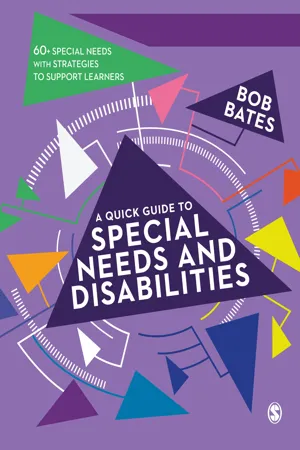
- 256 pages
- English
- ePUB (mobile friendly)
- Available on iOS & Android
A Quick Guide to Special Needs and Disabilities
About This Book
A Quick Guide to Special Needs is an easy go-to guide for busy teachers, SENCOs, practitioners and anyone else who is interested in pragmatic solutions to the challenges of teaching children and young people with additional needs.
Detailing over 60 conditions which cause people to have additional needs, Bob Bates helps you broaden your understanding of different physical, neurological, psychological, and developmental needs with accessible bite-sized explanations of the conditions, best practice approaches to working with these learners, and how to apply them to your everyday teaching. Each individual need is explained over a 2-page spread and every entry includes:
- Case studies encouraging you to reflect on real-life situations to understand the impact each condition has on people and how they and their parents deal with it.
- Do it steps offering a simple step-by-step approach that you can follow in order to meet additional needs arising out of these conditions.
- Important steps for the classroom specifically for teachers to use.
- Recommended reading, suggesting books, articles and websites where further information on specific conditions are available.
Whether you're a newly qualified or experienced teacher, or simply want to further your understanding on the vast variety of individual needs, this guide is the ideal dip-in dip-outreference point for SEND. Also from Bob Bates:
Educational Leadership Simplified
Learning Theories Simplified
Frequently asked questions
Information
Table of contents
- Cover
- Half Title
- Publisher Note
- Title Page
- Copyright Page
- Acknowledgements
- Acknowledgements
- Contents
- About the Author
- Acknowledgements
- Glossary of Terms
- How to Use This Book
- Introduction
- Part 1 Physical Impairments
- 1 Allergies
- 2 Asthma
- 3 Brittle Bone Disease
- 4 Cerebral Palsy
- 5 Chronic Fatigue Syndrome
- 6 Cystic Fibrosis
- 7 Diabetes
- 8 Epilepsy
- 9 Foetal Alcohol Syndrome
- 10 Haemophilia
- 11 Hearing Impairment
- 12 Heart Disease
- 13 Hemiplegia
- 14 Hydrocephaly
- 15 Juvenile Rheumatoid Arthritis
- 16 Microcephaly
- 17 Motor Neurone Disease
- 18 Multiple Sclerosis
- 19 Multi-Sensory Impairment
- 20 Muscular Dystrophies
- 21 Restricted Growth
- 22 Sickle-Cell Anaemia
- 23 Skin Diseases
- 24 Spina Bifida
- 25 Vision Impairment
- 26 Wheelchair Users
- Part 2 Neurological and Psychological Disorders
- Part 2A Neurological Disorders
- 27 Asperger Syndrome
- 28 Ataxia
- 29 Attention Deficit Hyperactivity Disorder
- 30 Autism
- 31 Down Syndrome
- 32 Dyscalculia
- 33 Dyslexia
- 34 Dyspraxia
- 35 Sensory Processing Disorder
- 36 Speech and Language ImpairmentS
- 37 Tourette Syndrome
- 38 Williams Syndrome
- Part 2B Psychological Disorders
- 39 Attachment Disorder
- 40 Bipolar Disorder
- 41 Depression
- 42 Eating Disorders
- 43 Emotional Behavioural Disorders
- 44 Generalised Anxiety Disorder
- 45 Obsessive Compulsive Disorder
- 46 Personality Disorder
- 47 Phobias
- 48 Post-Traumatic Stress Disorder
- 49 Schizophrenia
- 50 Selective Mutism
- Part 3 Other Additional Needs
- 51 Disaffected, Disengaged or Excluded
- 52 Emotional Distress
- 53 English as an Additional Language
- 54 Gifted or Talented
- 55 Learning Difficulties
- 56 Munchausen by Proxy Syndrome
- 57 New Migrants
- 58 Obesity
- 59 Poor Conduct Disorder
- 60 Socio-Economic Difficulties (Poverty)
- 61 Travellers and Gypsies
- 62 Victims of Abuse
- 63 Victims of Forced Marriages
- 64 Young Carers
- 65 Young Offenders
- Part 4 Approaches for Working with Children and Young People with Additional Needs
- 66 Children
- 67 Parents
- 68 Teachers
- 69 Cognitive Behavioural Therapy (Cbt)
- 70 Fundatia Inima de Copil (Heart of a Child Foundation)
- 71 Heuristic Play
- 72 Jolly Phonics
- 73 Makaton
- 74 Mentalisation-Based Therapy (MBT)
- 75 Mentoring and Critical Friendship
- 76 Mindfulness
- 77 Neurodiversity
- 78 Neuro-Linguistic Programming (NLP)
- 79 Portage Home Learning
- 80 Social Communication Emotional Regulation Transactional Support (SCERTS) Model
- 81 Solihull Approach Programme
- 82 Special Educational Needs Coordinators (SENCOs)
- 83 Transactional Analysis
- 84 Treatment and Education of Autistic and Communication Handicapped Children (TEACCH) Programme
- 85 Understanding Intelligence
- 86 Yoga and Tai chi
- Final Thoughts
- Index